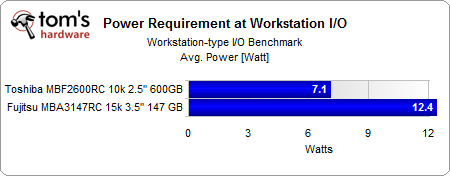Changing Of The Guard: 2.5” Hard Drives In The Enterprise
2.5” Vs. 3.5” Performance And Power

We’ve covered performance and power previously, but it makes sense to detail how 2.5" and 3.5" drives differ in these regards. The performance index above is based on all of our results, weighting throughput and I/O at 40% and PCMark Vantage at 20 percent. You might want to check out our benchmark section that lists all of the individual results, but the overall message is pretty straightforward: the new 600GB drive generation on 2.5” and 10,000 RPM delivers very solid throughput of up to roughly 150 MB/s, but it can’t beat 3.5” 15,000 RPM drives when it comes to IOPS. Still, a little performance impact is very acceptable given the following advantages for 2.5” over 3.5”.

Power requirements are the next interesting difference. While the 15,000 RPM drive requires between 7.8W at idle and 12.4W at maximum I/O activity, the 600GB 2.5” Toshiba MBF2600RC roughly cuts this power profile in half. Only pulling 7.1W at peak power during workstation I/O activity is impressive. Additionally, idle power is even more attractive at 3.5W.
Finally, there’s efficiency. Knowing that power consumption drops more steeply than performance, we know that performance per watt and even capacity per watt look much better for 2.5” products.
Get Tom's Hardware's best news and in-depth reviews, straight to your inbox.
Current page: 2.5” Vs. 3.5” Performance And Power
Prev Page 2.5” Vs. 3.5”: Drive Examples Next Page 2.5” Vs. 3.5”: Capacities And Cost